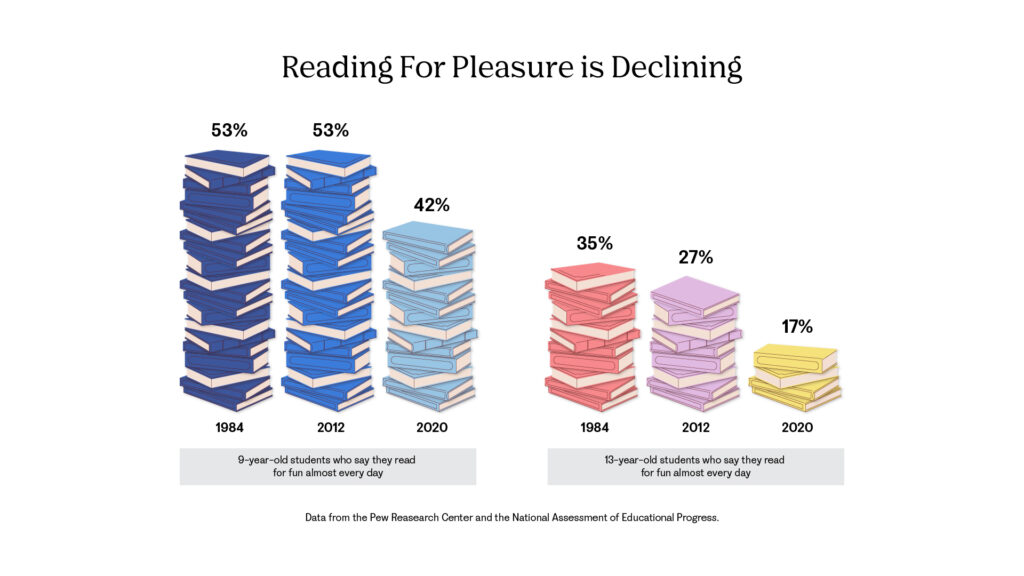When was the last time your child sat down and did some deep reading? When was the last time your child got lost in a book? If your child is a digital native, the answer is probably not recently. In today’s digital society, books compete with smartphones for student’s attention.
According to research from the Nation’s Report Card and the National Assessment of Educational Progress, student reading rates are declining. These numbers apply to pleasure reading, but in-school reading is also affected.

Teachers at both the high school and postsecondary levels note a decline in students’ ability to manage the required readings. Students use alternate methods to engage with reading material, whether it is audiobooks, YouTube videos, TikTok, ChatGPT, or online summaries—anything other than sitting down and reading.
But why are students reading less? Explanations are varied: shorter attention spans, a decline in proper reading instruction, the pandemic, and even extracurricular activities. But education experts point to smartphones as the biggest contributor to declining reading skills.
Even well-read adults with careers based in reading report being distracted by their phones.
But why is focusing on a book so challenging?
The Challenge of Reading
According to Maryanne Wolfe, author of “Reader, Come Home: The Reading Brain In A Digital World” and the Director of the Center for Dyslexia, Diverse Learners and Social Justice, reading skills are not a natural, instinctual part of the brain like vision or scent. source. This means that every part of reading requires effort. Reading skills are built and strengthened over time with practice and intention.
Basically, reading is hard and slow, and your phone has programmed your brain to want quick and easy.
She says deep reading—the ability to read intentionally and for a long period of time—reflects the brain’s ability to go beyond its natural state. She also says that the more we read online, the more our neural pathways develop screen reading as a preference.
So it’s no wonder that students find offline reading more challenging than it used to be.
Your Brain, Online
Flashes, popups, chimes, and dings: there’s a lot happening online that can steal a reader’s attention. When we read online, our natural inclination is to skim, search, and browse. We rarely read line by line, taking in the words. The more we read online, the more our brains become wired to prefer skimming.
Skimming is a natural part of reading in a digital world. Unfortunately, skimming is a shallower process, leading to less retention and recall.
Comparatively, reading a book is the opposite of the digital world. Unlike the fast and shallow world online, reading a book is slow, deep, deliberate, and time-consuming.
When students find deep reading challenging, it might make them think their reading skills are poor. For this reason, avoiding reading makes sense. However, the reality is that even highly skilled readers can struggle with this process. Just because students find reading for a long period challenging does not mean they are not good at it. (source)
Even in a digital world, reading deeply is a very valuable skill.
Deep Reading
Deep reading is a thoughtful and deliberate process that can deepen comprehension. It’s a slow process. that involves many complex cognitive skills that work together to build understanding, including deductive reasoning, analysis, reflection, and insight.
Reading deeply expands one’s mind—quite literally. The more students practice this skill, the more neural connections they build to make this process easier.
Tips to Help Students Build Stronger Reading Skills for Deep Reading
Putting away the phone and being intentional about building reading takes commitment and discipline, but it is possible. Here are six ways to rebuild deep reading skills:
- Be uncomfortable. Deliberately avoiding technology to focus on reading might feel uncomfortable. Smartphones and other influences have trained the brain to want immediacy. You are fighting against a built-up habit.
- Reduce Distractions. Notice when thoughts drift. When you find your mind has wandered, take note and redirect back to the page.
- Make notes as you read. Writing while reading engages more areas of the brain and makes reading active, which boosts comprehension.
- Go at your own pace. There is no rush to read quickly.
- Set a timer. Read for 20 undistracted minutes and increase time incrementally.
- Practice often. Read slowly and deliberately.
Help your student build stronger reading skills with help from GradePower Learning. Contact a location near you to learn more.





